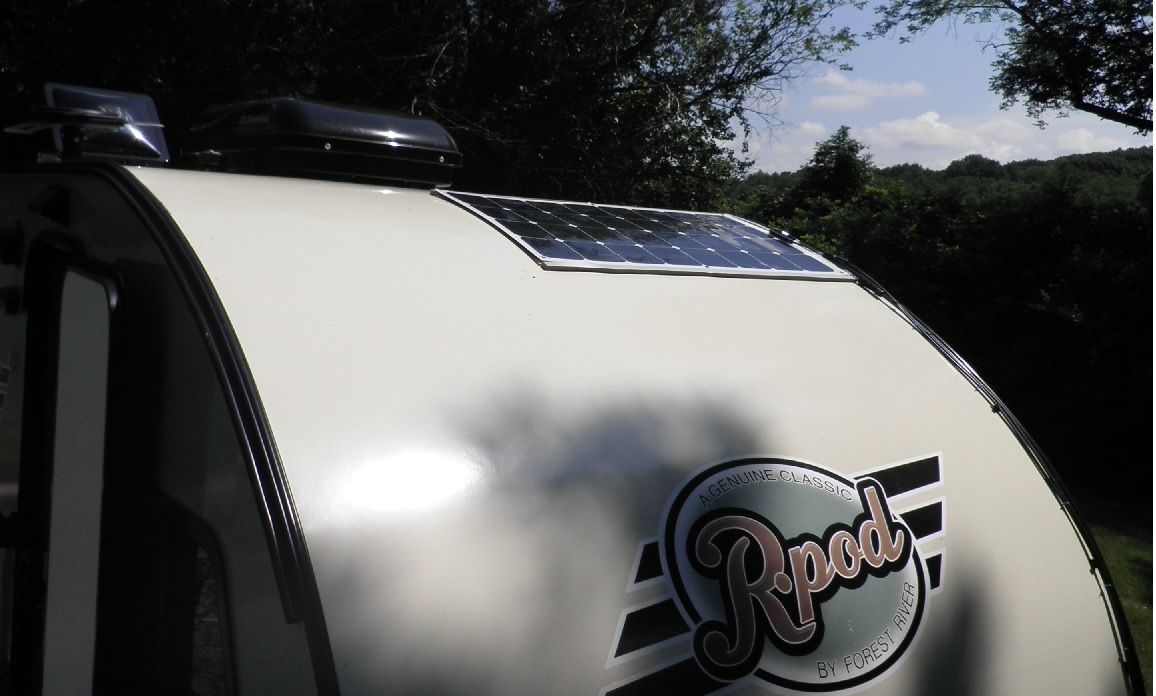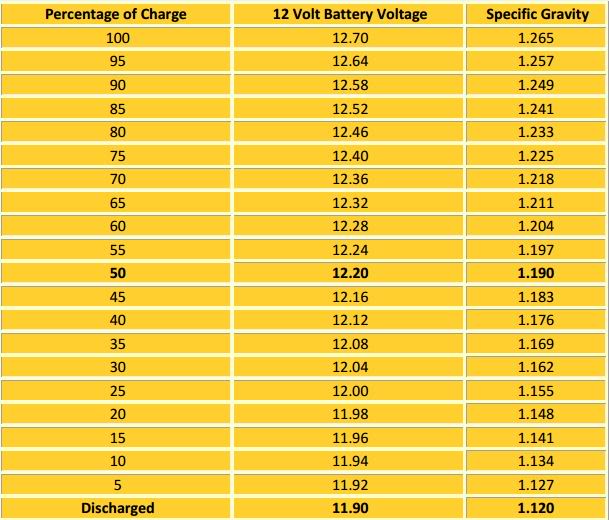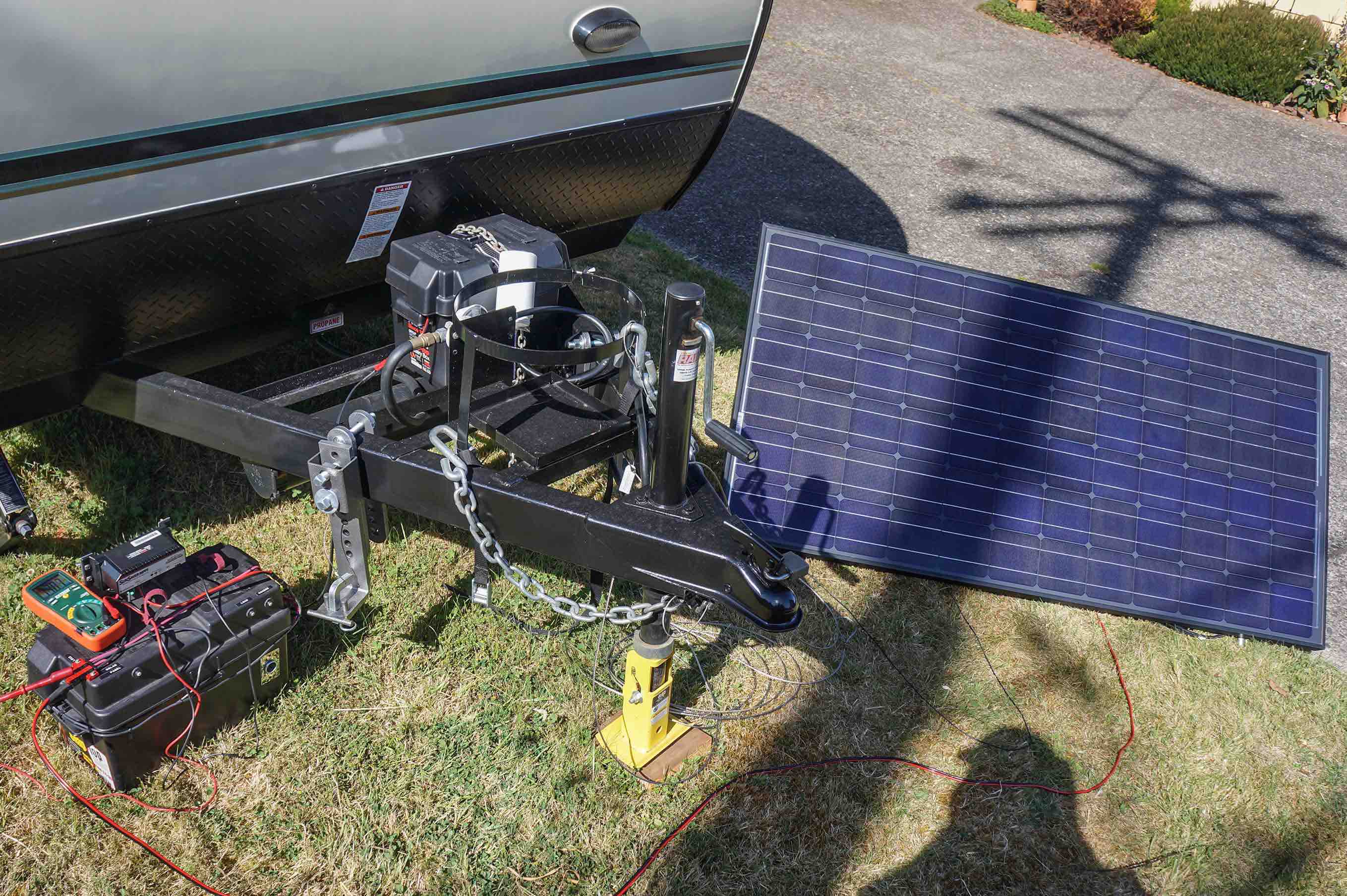
 |
|
Post Reply 
|
Page <1 23456 14> |
| Author | ||||||
Don Halas 
Senior Member 
Joined: 01 Jul 2015 Location: Connecticut Online Status: Offline Posts: 190 |
 Topic: Connecting a 100 watt solar panel to Zamp port Topic: Connecting a 100 watt solar panel to Zamp portPosted: 17 Jul 2016 at 1:37pm |
|||||
|
As promised, the finished project:
First, the primary purpose for my solar installation is to remove the need to supply 120v from my house during the summer when the Pod sits in my yard. There will be infrequent need for power resources mostly limited to the parasitic draw. Occasionally the fan, radio or lights might be used for a short period of time when in my yard. We do not intend on doing a lot of off the grid, dry camping. In fact, we we will probably never go more than 48 hours relying solely on Pod power. So it's requirements on the road are, at this point minimal. So, the installation includes a flexible HQST monocrystaline 12V 100watt flexible panel https://www.amazon.com/gp/product/B017OMTAV6/ref=od_aui_detailpages03?ie=UTF8&psc=1  The panel is being attached to the Pod using 1" wide Extreme Industrial Velcro (brand) tape. The original intent was to have 3 configurations I could mount the panel depending on the angle of the sun. There was a Major fail with this. The velcro sticks against the two tapes extremely well, the adhesive against the Pod vinyl fails when the tape is wet! So, I am now augmenting the 1" velcro with 1/2" VHB tape. The tape is helping secure the Velcro to the Pod vinyl. I'll keep an eye on this as I thing the real problem is the vinyl on the Pod itself and it's being a poor recipient of the glue. I have also put 1/2" foam insulation tape surrounding the panel mounting. The intent is to reduce any air that might try to get under the panel by wind. It may also reduce water to the velcro, but that would be a plus and beyond the original requirement.  The panel is wired into a Morning Star Sun Saver charge controller. https://www.amazon.com/gp/product/B017OA5DH8/ref=oh_aui_detailpage_o05_s01?ie=UTF8&psc=1 The charge controller is capable of managing a second 100 watt solar panel if that's what I need in the future. It looks like a good fit and so far seems to be performing well.  The charge controller is mounted in the battery box. I needed to get a larger box for this, but it only cost about $8.00. Connectors cost more than that! I also installed a voltmeter/ammeter to measure the charge between the charge controller and the battery. This is more flash than function but it will help acknowledge the suns yield.  |
||||||
 |
||||||
WillThrill 
Senior Member 

Joined: 04 Jul 2014 Online Status: Offline Posts: 298 |
 Posted: 10 Jul 2016 at 9:54pm Posted: 10 Jul 2016 at 9:54pm |
|||||
All very true. Checking the specific gravity of each cell is another excellent means of measuring state of charge, and it's even more reliable than a voltmeter but obviously far less convenient. I didn't want to get too far in depth with everything for a new person considering that there are literal volumes of information about lead acid batteries.
|
||||||
|
"Not all those who wander are lost." Tolkien
2014 Hood River 177 2005 GMC Envoy XL |
||||||
 |
||||||
Rustler 
Senior Member 
Joined: 07 May 2016 Location: S. Oregon Coast Online Status: Offline Posts: 100 |
 Posted: 10 Jul 2016 at 9:07pm Posted: 10 Jul 2016 at 9:07pm |
|||||
You've given a lot of very sound counsel here, WillThrill. I would like to add that it is beneficial that your volt meter is accurate to 2 decimal places. Measuring to the 1/10th volt is usually very approximate if measuring battery state of charge. Most often the final digit at the end is plus or minus 1 digit. With 2 digits (1/100) the measured state of charge (SOC) is more accurate. It's best that the battery is neither being charged or discharged when taking the voltage measurement - the rest voltage. This chart gives the SOC at rest.  Voltage also varies with temperature and flow of current into or out of the battery. The following link gives a good discussion of SOC when the battery is not at rest: With all the variables in play, measurement of state of charge is not exact. But it can be of some use nonetheless.
|
||||||
|
Russ
2009 Toyota RAV4 V6 w/ tow package 2016 Rpod 171 HRE |
||||||
 |
||||||
WillThrill 
Senior Member 

Joined: 04 Jul 2014 Online Status: Offline Posts: 298 |
 Posted: 10 Jul 2016 at 5:19pm Posted: 10 Jul 2016 at 5:19pm |
|||||
I've checked the manual, and it is indeed a 3 stage (smart) controller. When you aren't using your batteries, you'll need to leave your solar panel connected to your batteries in order to keep them fully charged, leave your Pod plugged in when in storage, or else move the batteries to a location where they can be charged by a 120v outlet charger. Every minute that a lead acid battery isn't 100% charged is doing some amount of irreversible damage to it. But keep in mind that five years is about the upper limit to typical RV batteries' lifespan.
Yes, if you can. Most marine/deep cycle batteries have little caps on top of the battery that can be popped off, revealing the six cells inside (2 volts each). The water level should be to the bottom of the little tabs that stick down inside. If they aren't slowly and carefully refill them with distilled water only; this is available from your local grocery store. Be sure to wear eye protection, gloves, and old clothes when doing this. Any drop of acid that gets on your clothes will eat a hole through them in a little while. This process should be done every six months or so. Some deep cycle batteries are sealed, preventing you from refilling them.
Yes, that is fine and will charge your batteries using the Pod's onboard converter/charger. A 'dog bone' adapter is generally preferred over the 'hockey puck' style adapters, but both will work.
To check the state of your batteries accurately, you need to use a voltmeter. There are several ways of doing this, depending on how 'permanent' you want to make it. The fastest way is to get a $10 voltmeter and manually check the DC voltage of the batteries. Here's a guide: 12.6 = 100%, 12.4 = 75%, 12.2 = 50%, 12.0 = 25%. You don't want to go below 50% unless you really need to as this begins to do long-term harm to the batteries. LED lights draw very little power, and the water uses a fair amount when running, but it's not running for long periods usually. Your refrigerator will draw a bit when running on propane, but not much.
One 20# tank of propane will generally keep your refrigerator, water heater (running only when needed), and stove going for at least 2-3 weeks. To check the propane level inside, pour some hot water down the side and then feel for the line where the tank goes from warm to cold; that's the amount of propane you have left. Keep in mind that a 'full' propane tank is at 80% of its capacity.
That's what this forum is all about.
 |
||||||
|
"Not all those who wander are lost." Tolkien
2014 Hood River 177 2005 GMC Envoy XL |
||||||
 |
||||||
Sandybeach 
Newbie 
Joined: 03 Jul 2015 Online Status: Offline Posts: 12 |
 Posted: 10 Jul 2016 at 4:20pm Posted: 10 Jul 2016 at 4:20pm |
|||||
|
Will Thrill
"However, a solar panel with a smart charge controller (NEVER use a solar trickle charger with a solar panel rated above 15 watts;" I am pretty new to this- How do I know if the controller I got with my little 40 W solar panel is trickle or smart? I bought a foldable 40W solar panel at Canada Tire last year end of season with a little controller. I think it might be Coleman and it was $99. I also have some more dumb questions. 1. Do i have to check my factory battery for water occasionally? 2. When i use my Honda 2000 generator at first we just plugged our devices into the Honda. Then we got smart and plugged the Honda into the rpod electric with a adapter. Is that Ok and does that charge the batteries or not? I will say we just got back from Acadia, dry camping for 9 days and no real issues with power. We have 2 batteries, used those for lights and water pump. Used the generator for a bit in AM when we needed to charge our devices. WE set up the small solar every day and I was always around 2 to 3 dots of battery power. I was surprised. Also 1 tank of propane kept fridge going all week, plus a few kettles of water. THank you for all the help Sandy
|
||||||
|
2015 Rpod 178
2006 Toyota 4 runner 1 happy husband after 25 yrs of tenting. |
||||||
 |
||||||
WillThrill 
Senior Member 

Joined: 04 Jul 2014 Online Status: Offline Posts: 298 |
 Posted: 09 Jul 2016 at 11:55pm Posted: 09 Jul 2016 at 11:55pm |
|||||
|
A little bump considering that many questions have arisen about this topic lately.
|
||||||
|
"Not all those who wander are lost." Tolkien
2014 Hood River 177 2005 GMC Envoy XL |
||||||
 |
||||||
Don Halas 
Senior Member 
Joined: 01 Jul 2015 Location: Connecticut Online Status: Offline Posts: 190 |
 Posted: 27 Jun 2016 at 7:40am Posted: 27 Jun 2016 at 7:40am |
|||||
|
Rustler, someone did their homework.
Nice work. |
||||||
 |
||||||
Rustler 
Senior Member 
Joined: 07 May 2016 Location: S. Oregon Coast Online Status: Offline Posts: 100 |
 Posted: 27 Jun 2016 at 2:50am Posted: 27 Jun 2016 at 2:50am |
|||||
John, with a higher voltage solar array you are quite correct that the current would be lower at the same power rating. This does have advantages in having lower voltage drop (and lower power loss) with a given power output and wire size. Consider two examples:
For a given wire gauge the setup in example 2. could go twice as far with the same voltage drop. You get a further advantage in that the percentage voltage drop would be 1/2 since it is based on 25 volts, not the 12 volts of example 1. Now to get that advantage, you don't need to wire two panels in series. They make higher voltage solar panels that are used in high voltage DC systems or in grid tied systems. For instance I have a 36 volt, 185 watt panel made for a grid-tied solar system. It puts out around 5.1 amps at 36.4 volts. With that panel I can have less than 3% voltage drop with 10 gauge wire running 75 feet. Here's a good link to a handy voltage drop calculator. The good news is that you do NOT have to run your camp trailer at the higher voltage. A maximum power point tracking controller (MPPT) runs at the higher voltage for maximum efficiency, lower power/voltage loss in your wiring. But it then conveniently does a voltage conversion to provide for charging a 12-volt battery. In clear text you can use a 36 volt panel to charge a 12-volt battery with a MPPT controller. A 36 volt panel can be found with a diligent search on the internet. They are actually quite common, many thousands being made for the grid-tied market. Here's an example of such a panel at a reasonable price: Back to the example of my 185 watt panel. Between the solar panel and controller, the voltage is around 36 volts at 5 amps. From the controller to the battery the voltage is between 12 and 14.7 volts depending on the battery charging needs. Current into the battery is up to 15 amps. Since the MPPT controller is mounted on the battery box, the panel can be up to 75 feet away (with 10 gauge wire). The higher current, low voltage line running from controller to the battery is around a foot long, with minimum voltage/power loss. Here's a photo of the 185 watt panel, MPPT controller and battery. I'm sorry that the photo is so enormous. I can't seem to get it small enough to view the whole thing without scrolling left and right.  The charge controller is a Morningstar SSMPPT-15L. It runs around $225. But considering the advantages of a high voltage panel, the extra cost is well worth it. I hope that my thoughts here will be of use, John. If you have any questions, let me know. I would be pleased to be of help. |
||||||
|
Russ
2009 Toyota RAV4 V6 w/ tow package 2016 Rpod 171 HRE |
||||||
 |
||||||
WillThrill 
Senior Member 

Joined: 04 Jul 2014 Online Status: Offline Posts: 298 |
 Posted: 26 Jun 2016 at 8:15pm Posted: 26 Jun 2016 at 8:15pm |
|||||
|
A 48 volt system would basically require a completely new electrical system: new converter/charger, new refrigerator capable of running on 48 volts, new water heater, new water pump, new fan, new sound system. In the context of an RV, I can't find a good reason to do all of that, and you would need a minimum of four 12 volt batteries linked in series (not easy to do on the tongue of a Pod).
If you're talking about an off-grid cabin, it can make sense to go with a 48 volt system, but not in an RV. With multiple solar panels on an RV, you would simply connect them in parallel to maintain 12 volt (nominal) output. This has the advantage of not bringing down the whole array if one panel gets shaded or something on the panel itself like a bird dropping, a serious concern for solar arrays wired in series. True, you need heavier gauge wire with parallel wiring, but in an RV, the amperage and distances aren't a big concern anyway.
|
||||||
|
"Not all those who wander are lost." Tolkien
2014 Hood River 177 2005 GMC Envoy XL |
||||||
 |
||||||
furpod 
Moderator Group - pHp 
Joined: 25 Jul 2011 Location: Central KY Online Status: Offline Posts: 6128 |
 Posted: 23 Jun 2016 at 11:48am Posted: 23 Jun 2016 at 11:48am |
|||||
In large arrays, like for a cabin or home, this is how it is done.. with one caveat.. They are not running a "12v" system. You use a higher voltage sytem from the get go. Most home/cabin, etc installations run at 48v. Some at 24. Depends on the total load allowed for. This could be done with an RV.. but not real easy in the confines of a Pod. Quality higher input/output inverters also get expensive quick.
Next time I am over in Menonite country, I will get a picture of one of their systems running my favorite country store/bakery... It's a 48v system built on Group 8D batteries in series. Just the battery bank is big as a Pinto..
|
||||||
 |
||||||
Post Reply 
|
Page <1 23456 14> |
| Forum Jump | Forum Permissions  You cannot post new topics in this forum You cannot reply to topics in this forum You cannot delete your posts in this forum You cannot edit your posts in this forum You cannot create polls in this forum You cannot vote in polls in this forum |